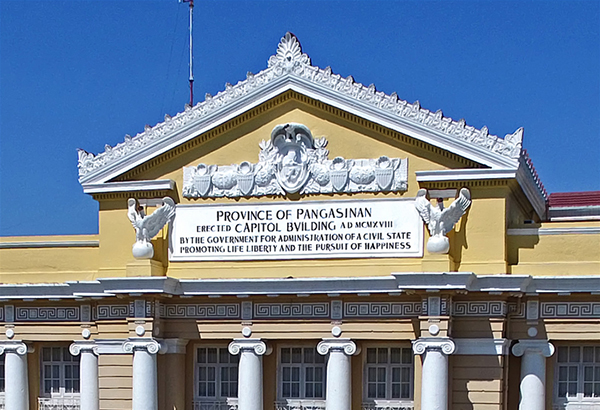Lovely Lingayen


Detail of the facade of the provincial capitol shows the great work architect Rene Luis Mata accomplished in its conservation as heritage.
On this day before Christmas, we pick up on our continuing series on Philippine plazas and parks with a feature on a grand park and its landmark building in Lingayen, Pangasinan. I’ve written about a few other town and city plazas in this central Luzon province, but Lingayen, although it has a beautiful old city plaza, boasts a unique setting found in its provincial government center.
Lingayen is the capital of the province of Pangasinan. The famed Lingayen Gulf forms the northern border of the town, which occupies over 60-square kilometers on either side of the Agno River.
Lingayen is a town with two distinct districts: the old poblacion, which evolved in the Spanish period around a classic plaza, and the American extension north of the old town center. I only had time to visit the American section because I wanted to see the elegant provincial capitol building. A good friend and fellow member of the Heritage Conservation Society, architect Rene Luis Mata, was in charge of bringing it back to its former glory over a decade ago.
The Americans built on the old Spanish gridded framework of towns in the Philippines, keeping most of them intact. They did, however, build extensions. These were based on “city beautiful” geometry, and were expressed specifically in provincial government centers established in the capitol towns of each province.
The distinctive character of these provincial government centers, built in the American to the Commonwealth periods, was expressed through a large capitol building designed in the neo-classic style of architecture preferred for civic structures before the war. These were set in large grounds, with many, like Cebu and Bacolod cities’ provincial capitols connected by a wide boulevard to the old town center.
Lingayen’s provincial capitol building is acknowledged as one of the country’s most beautiful civic structures. This is due to its architecture as well as its setting. The American architect Ralph Harrington Doane designed the building in the 1910s. He was the chief consulting architect of the Bureau of Public Works. He had replaced the better-known William E. Parsons, who developed Daniel Burnham’s master plan for Manila and Baguio into a handful of completed buildings in the neo-classic style.
The Lingayen provincial capitol was completed in late 1918 and inaugurated the next year. It is an elegant structure with well-composed facades that faced both the Lingayen Gulf in the north, as well as southern approach from the old town center.
The building is set in a large formal setting ruled by symmetry and a formalistic layout. The park is today named after Governor Aguedo Agbayani, the longest serving governor, whose terms of office covered the 1970s to the 1990s.
The space reminds me of the equally commodious park in front of the Bacolod provincial capitol. The park covers close to three hectares of open green space. It lacks the dramatic and huge formal lagoon of Bacolod’s capitol complex, but is nonetheless a popular recreational spot for locals.
Unlike Bacolod’s complex, but similar to Cebu’s, is the fact that Lingayen’s provincial capitol and park is the terminus of a long and wide boulevard. Maramba Boulevard is as grand as Agbayani Park. It is 40 meters wide with a wonderful central tree-lined greenway that is 20 meters across. It is named after Daniel Maramba, the province’s premier pre-war political leader.
The one-kilometer boulevard is relatively well maintained. On the other end of the boulevard is a simple but stately memorial setting for Congressman Maramba. From here there is a short 500-meter link to the old town center. I really have to take a trip back to visit and document this, especially because of the plaza’s striking Art Deco Rizal memorial.
Lingayen and Pangasinan offer many interesting destinations of both natural and built heritage. The provincial capitol, its plaza and its large compound of about 30 hectares, WWII sites, and Lingayen beach are key attractions. The NLEX extensions also make the town and province more accessible from Metro Manila.
Lingayen is still a first-class municipality with a population of about 100,000. Dagupan is the nearest major urban center. This benefits Lingayen as urbanization has not brought its attendant pressures of traffic and sprawl on the town. It would be advisable though that Lingayen plan for the eventual increase in population and development. The provincial complex and Maramba Boulevard are key to this future expansion.
I rate Agbayani Park a 9 out of 10 because it is large, tree-filled, and uncompromised by inappropriate structures. It is also great because of Maramba boulevard, which is its natural extension, giving Lingayen one of the largest areas of park land and open space among towns in the Philippines. And that is a gift that keeps on giving.
* * *
Feedback is welcome. Please email the writer at paulo.alcazaren@gmail.com.



















